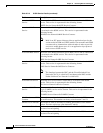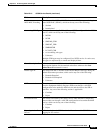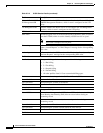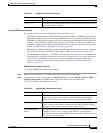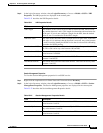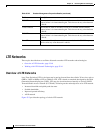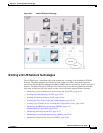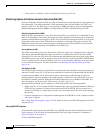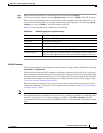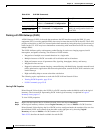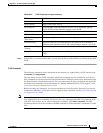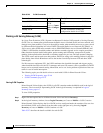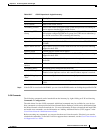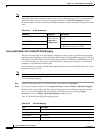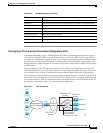
25-42
Cisco Prime Network 4.0 User Guide
OL-29343-01
Chapter 25 Monitoring Mobile Technologies
LTE Networks
• Viewing the Local Mobility Anchor Configuration (LMA), page 25-106
Monitoring System Architecture Evolution Networks (SAE-GW)
Systems Architecture Evolution (SAE) has a flat all-IP architecture with separation of control plane and
user plane traffic. The main component of SAE architecture is the Evolved Packet Core (EPC), also
known as SAE Core. The EPC serves as an equivalent to GPRS networks by using its subcomponents
Mobility Management Entities (MMEs), Serving Gateway (S-GW), and PDN Gateway (P-GW).
Mobility Management Entity (MME)
MME is the key control node for a Long Term Evolution (LTE) access network. It is responsible for idle
mode User Equipment (UE) tracking and paging procedure including retransmissions. It is involved in
the bearer activation/deactivation process and is also responsible for choosing the S-GW for a UE at the
initial attach and at time of intra-LTE handover involving Core Network (CN) node relocation. The
MME also provides the control plane function for mobility between LTE and 2G/3G access networks
with the S3 interface terminating at the MME from the SGSN. See
Serving Gateway (S-GW)
The S-GW routes and forwards user data packets, while also acting as the mobility anchor for the user
plane during inter-eNodeB handovers and as the anchor for mobility between LTE and other 3GPP
technologies. For idle state UEs, the S-GW terminates the downlink data path and triggers paging when
downlink data arrives for the UE. It manages and stores UE contexts, such as parameters of the IP bearer
service, network internal routing information, and so on. It also performs replication of the user traffic
in case of lawful interception. For more information, see Working with Serving Gateway (S-GW),
page 25-46.
PDN Gateway (P-GW)
The P-GW provides connectivity from the UE to external packet data networks by being the point of exit
and entry of traffic for the UE. A UE may have simultaneous connectivity with more than one P-GW for
accessing multiple PDNs. The P-GW performs policy enforcement, packet filtering for each user,
charging support, lawful interception, and packet screening. Another key role of the P-GW is to act as
the anchor for mobility between 3GPP and non-3GPP technologies such as WiMAX and 3GPP2. For
more information, see Working with PDN-Gateways (P-GW), page 25-44.
Running S-GW and P-GW services together as a SAE-GW provides the following benefits:
• Higher capacity—For a UE with one PDN connection that is passing through standalone S-GW and
P-GW services consumes 2 license units because both S-GW and P-GW services account for it
separately. SAE-GW as a single node consumes only one license unit for the same, thus increasing
the capacity.
• Cohesive configuration—Configuration and management of SAE-GW as a node is simpler to follow
and logical to explain.
See Viewing SAE-GW Properties, page 25-42 for details on how to view SAE-GW properties in Prime
Network Vision.
Viewing SAE-GW Properties
Prime Network Vision displays the SAE-GWs in a SAE-GW container under the Mobile node in the
logical inventory. The icon used for representing SAE-GW in the logical inventory is explained in
Logical Inventory Icons, page A-7.
To view SAE-GW properties:



